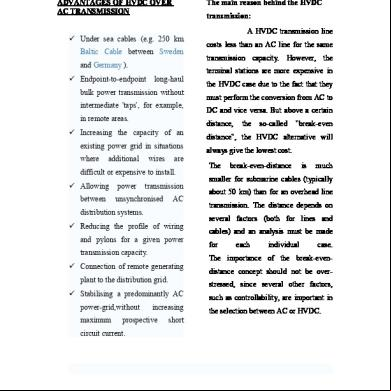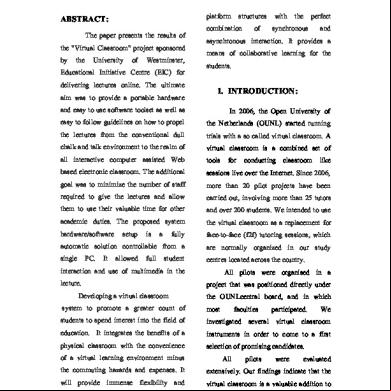Advantages Of Hvdc Over Ac Transmission 5k4p4o
This document was ed by and they confirmed that they have the permission to share it. If you are author or own the copyright of this book, please report to us by using this report form. Report 3b7i
Overview 3e4r5l
& View Advantages Of Hvdc Over Ac Transmission as PDF for free.
More details w3441
- Words: 669
- Pages: 4
ADVANTAGES OF HVDC OVER AC TRANSMISSION
The main reason behind the HVDC transmission:
Under sea cables (e.g. 250 km Baltic Cable between Sweden and ). Endpoint-to-endpoint
long-haul
bulk power transmission without intermediate 'taps', for example, in remote areas. existing power grid in situations additional
wires
are
difficult or expensive to install. Allowing between
power
transmission
unsynchronised
AC
distribution systems. Reducing the profile of wiring and pylons for a given power transmission capacity. plant to the distribution grid. increasing
prospective
circuit current.
terminal stations are more expensive in the HVDC case due to the fact that they must perform the conversion from AC to DC and vice versa. But above a certain the
so-called
"break-even
distance", the HVDC alternative will always give the lowest cost. The
break-even-distance
is
much
smaller for submarine cables (typically about 50 km) than for an overhead line transmission. The distance depends on several factors (both for lines and cables) and an analysis must be made for
each
individual
case.
distance concept should not be overstressed, since several other factors,
Stabilising a predominantly AC maximum
transmission capacity. However, the
The importance of the break-even-
Connection of remote generating
power-grid,without
costs less than an AC line for the same
distance,
Increasing the capacity of an where
A HVDC transmission line
short
such as controllability, are important in the selection between AC or HVDC.
(Typical
investment
Drawback
of
costs
for
the
an
overhead
HVDC
line
transmission
with
AC
and
HVDC).
system requires good communication between all the terminals.
Transmission system: The required static invertors are expensive and cannot be overloaded
APPLICATION
OF
HVDC
TRANSMISSION IN INDIA: Rihand
-
Delhi
and
very much. At smaller transmission
distances the losses in the static inverters
Chandrapur - Padghe were the
may be bigger than in an AC powerline,
first
and the cost of the inverters may not be
projects in India. The 1500 MW
offset by reductions in line construction
Rihand - Delhi transmission was
cost. In contrast to AC systems, realizing
put into service in 1990. It
multiterminal systems is complex, as is
transmits
expanding
Rihand
existing
schemes
to
long
distance
power -
HVDC
from
Singrauli
the
thermal
Controlling
power complex with a combined
power flow in a multiterminal DC
power generation of several
multiterminal
systems.
thousand MW, over a distance
of 814 km to Dadri station, close
(DOE),
to the capital of India.
sponsored a project under the
The
1500
Chandrapur
MW
-
transmission
Padghe
was
put
into
Govt.
national
of
HVDC
programme
on
India, R
&D
"Research,
Development and Training in
service in 1998. It transmits
HVDC
Transmission
power from the Chandrapur in
Technology" at IIT Kanpur.
the eastern part of Maharashtra over a distance of 736 km to the Mumbai area.
In
CONCLUSIONS:
1983-84,
when
The Project has provided the
decision was being taken to
necessary
introduce
India,
infrastructure facilities to carry out
Government of India ed
research and development activities
a
concerning
100
HVDC kV,
in 100
MW
analysis,
to
build
operation
an
and
experimental line HVDC project
control of integrated DC power system.
- called National HVDC project
In addition to manpower training the
- with the sole objective of
facilities have been extensively used for
developing
the following purposes:
indigenous
technology,
entrusted
its
BHEL.
This
execution
to
monopole
project
involved
conversion of one circuit of existing double circuit 220 kV AC lines between Lower Sileru (Andhra Pradesh) and Barsoor (Madhya Pradesh) to HVDC transmission on the same tower.
Consequently, in 1986,
the Department of Electronics
To develop software for simulation and analysis of HVDC systems. To develop and test new concepts in microprocessor based control and protection of HVDC converter and Static Var System.
To carry out research in
ac
system. b) Application of expert
a) Operation & Control of HVDC links connected to weak
REFERENCE: S.RAO – “EHV –AC, HVDC TRANSMISSION AND DISTRIBUTION ENGINEERING”. C.L.WADHWA – “ELECTRICAL POWER SYSTEMS”.
system
approach
converter control
for
HVDC
The main reason behind the HVDC transmission:
Under sea cables (e.g. 250 km Baltic Cable between Sweden and ). Endpoint-to-endpoint
long-haul
bulk power transmission without intermediate 'taps', for example, in remote areas. existing power grid in situations additional
wires
are
difficult or expensive to install. Allowing between
power
transmission
unsynchronised
AC
distribution systems. Reducing the profile of wiring and pylons for a given power transmission capacity. plant to the distribution grid. increasing
prospective
circuit current.
terminal stations are more expensive in the HVDC case due to the fact that they must perform the conversion from AC to DC and vice versa. But above a certain the
so-called
"break-even
distance", the HVDC alternative will always give the lowest cost. The
break-even-distance
is
much
smaller for submarine cables (typically about 50 km) than for an overhead line transmission. The distance depends on several factors (both for lines and cables) and an analysis must be made for
each
individual
case.
distance concept should not be overstressed, since several other factors,
Stabilising a predominantly AC maximum
transmission capacity. However, the
The importance of the break-even-
Connection of remote generating
power-grid,without
costs less than an AC line for the same
distance,
Increasing the capacity of an where
A HVDC transmission line
short
such as controllability, are important in the selection between AC or HVDC.
(Typical
investment
Drawback
of
costs
for
the
an
overhead
HVDC
line
transmission
with
AC
and
HVDC).
system requires good communication between all the terminals.
Transmission system: The required static invertors are expensive and cannot be overloaded
APPLICATION
OF
HVDC
TRANSMISSION IN INDIA: Rihand
-
Delhi
and
very much. At smaller transmission
distances the losses in the static inverters
Chandrapur - Padghe were the
may be bigger than in an AC powerline,
first
and the cost of the inverters may not be
projects in India. The 1500 MW
offset by reductions in line construction
Rihand - Delhi transmission was
cost. In contrast to AC systems, realizing
put into service in 1990. It
multiterminal systems is complex, as is
transmits
expanding
Rihand
existing
schemes
to
long
distance
power -
HVDC
from
Singrauli
the
thermal
Controlling
power complex with a combined
power flow in a multiterminal DC
power generation of several
multiterminal
systems.
thousand MW, over a distance
of 814 km to Dadri station, close
(DOE),
to the capital of India.
sponsored a project under the
The
1500
Chandrapur
MW
-
transmission
Padghe
was
put
into
Govt.
national
of
HVDC
programme
on
India, R
&D
"Research,
Development and Training in
service in 1998. It transmits
HVDC
Transmission
power from the Chandrapur in
Technology" at IIT Kanpur.
the eastern part of Maharashtra over a distance of 736 km to the Mumbai area.
In
CONCLUSIONS:
1983-84,
when
The Project has provided the
decision was being taken to
necessary
introduce
India,
infrastructure facilities to carry out
Government of India ed
research and development activities
a
concerning
100
HVDC kV,
in 100
MW
analysis,
to
build
operation
an
and
experimental line HVDC project
control of integrated DC power system.
- called National HVDC project
In addition to manpower training the
- with the sole objective of
facilities have been extensively used for
developing
the following purposes:
indigenous
technology,
entrusted
its
BHEL.
This
execution
to
monopole
project
involved
conversion of one circuit of existing double circuit 220 kV AC lines between Lower Sileru (Andhra Pradesh) and Barsoor (Madhya Pradesh) to HVDC transmission on the same tower.
Consequently, in 1986,
the Department of Electronics
To develop software for simulation and analysis of HVDC systems. To develop and test new concepts in microprocessor based control and protection of HVDC converter and Static Var System.
To carry out research in
ac
system. b) Application of expert
a) Operation & Control of HVDC links connected to weak
REFERENCE: S.RAO – “EHV –AC, HVDC TRANSMISSION AND DISTRIBUTION ENGINEERING”. C.L.WADHWA – “ELECTRICAL POWER SYSTEMS”.
system
approach
converter control
for
HVDC










